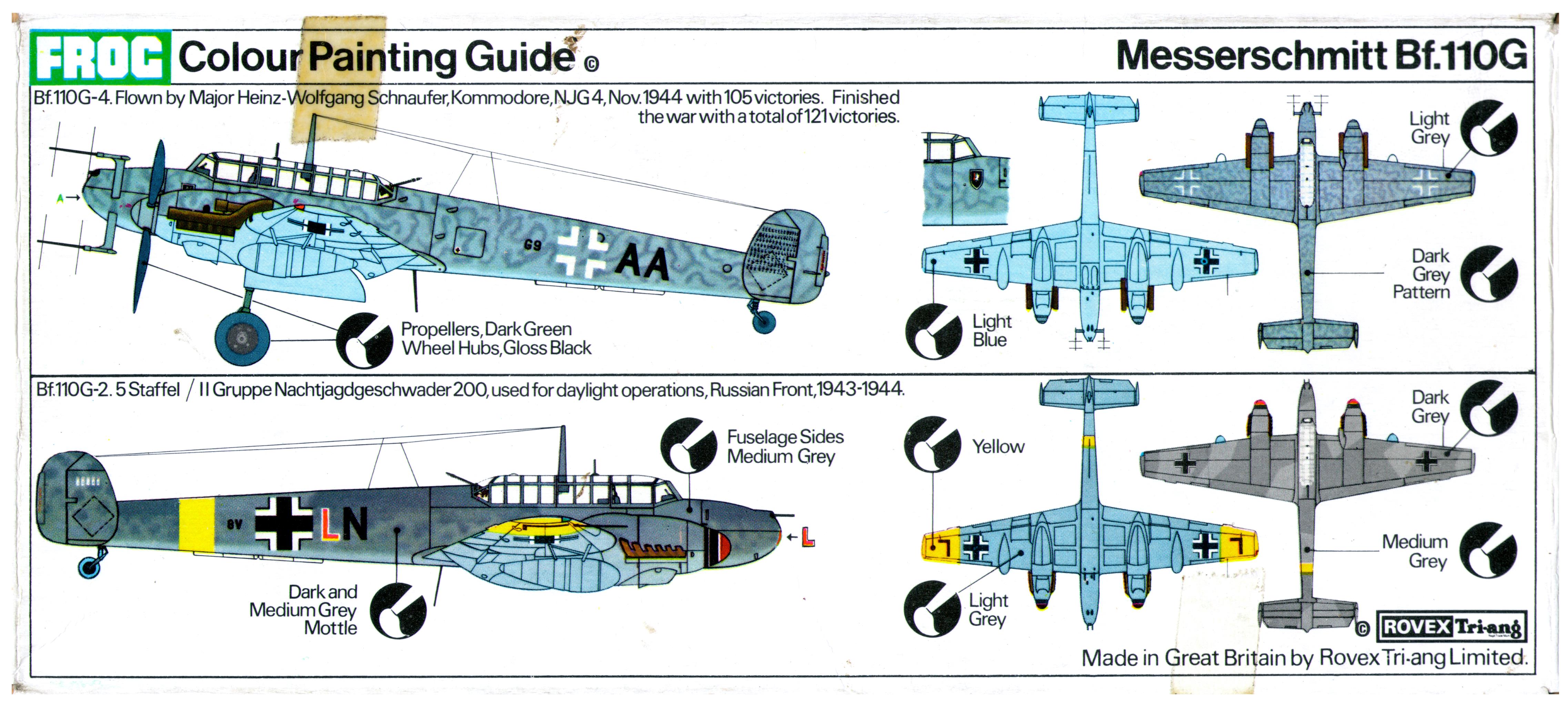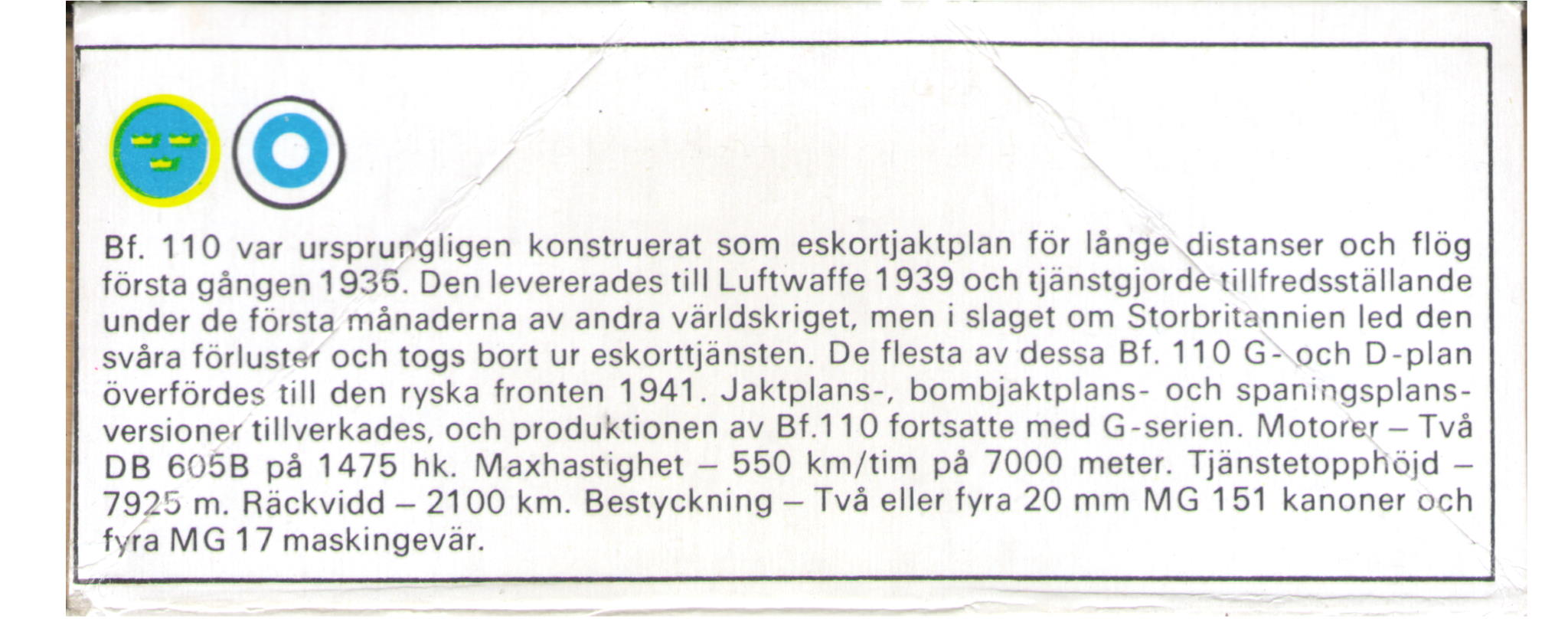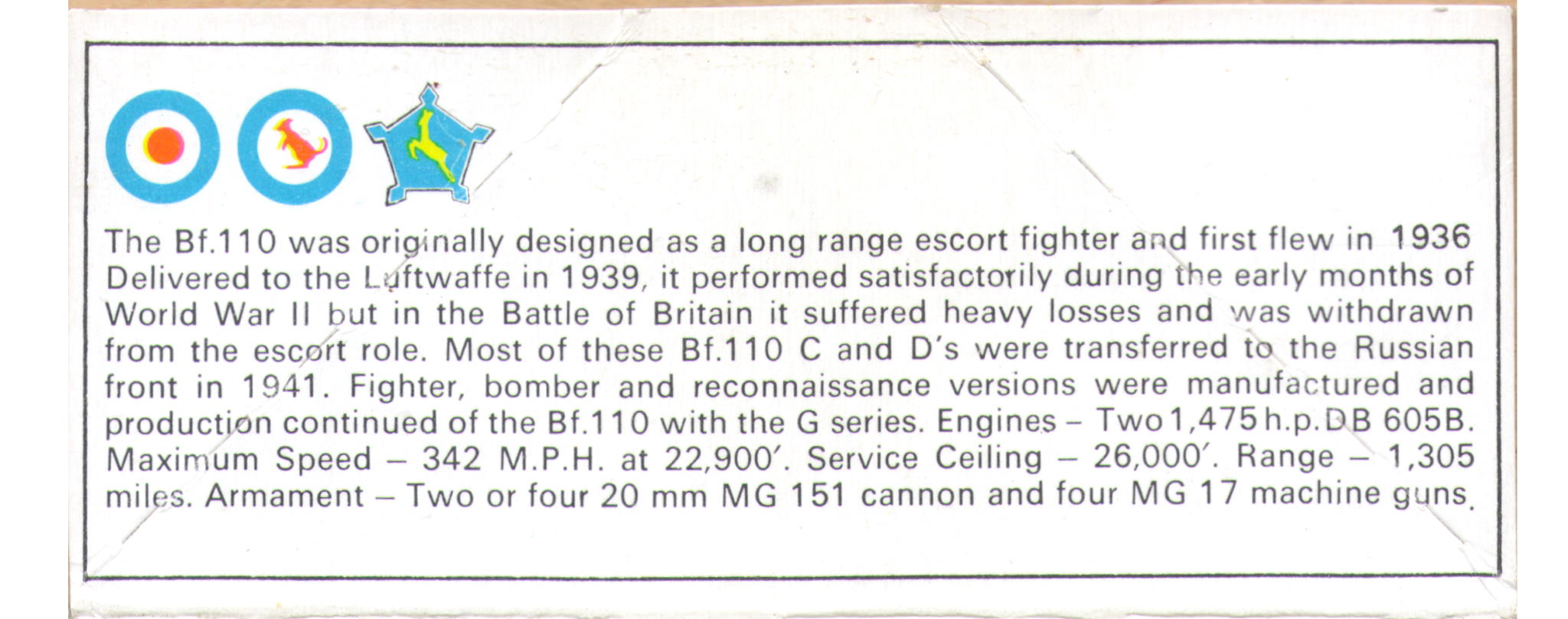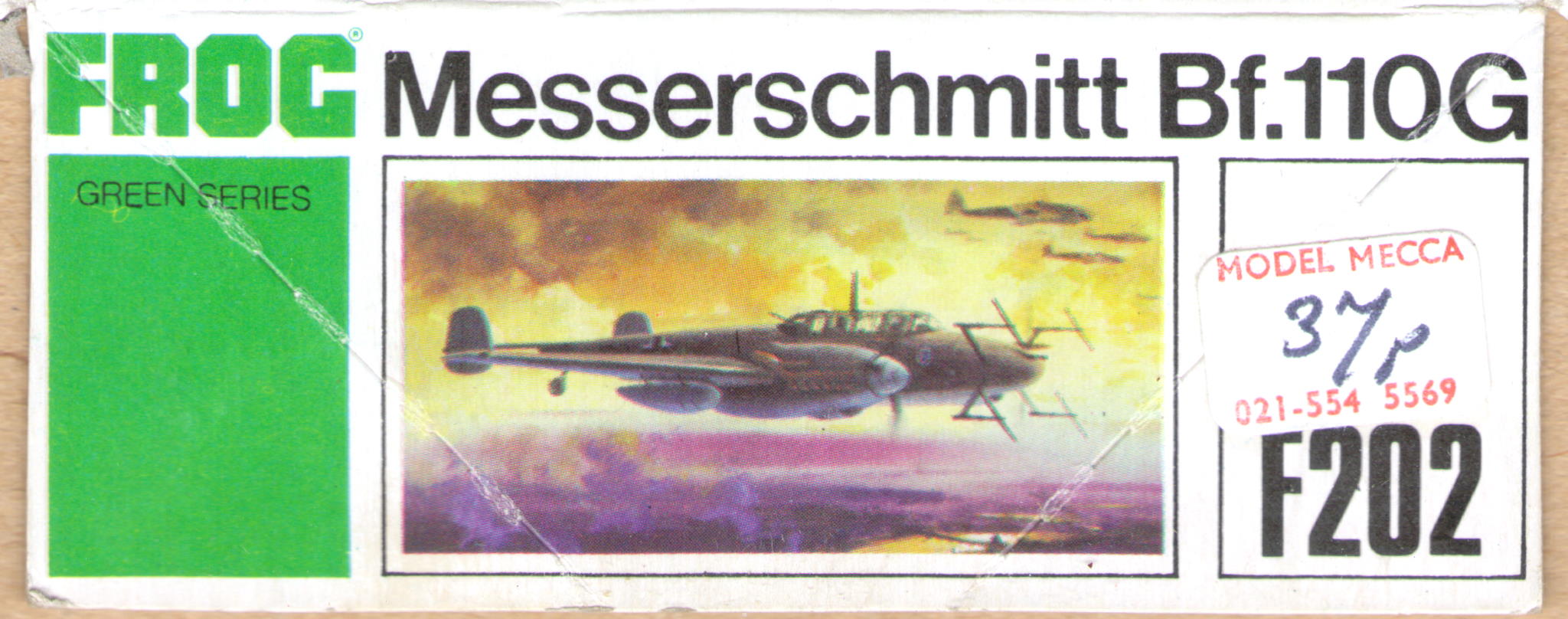









Messerschmitt Bf110G-4d/R3
| F202 | 1971-1974 | G1(G) | 140000 | 2xLW |
Sold as Bf 110G-2/G-4.
|
|
NEW AND IN VIEW
New Aircraft Kit
ROVEX TRI-ANG (FROG) LTD. Messerschmitt Bf 110G. 1/72 Scale. Price (U.K.) 37p. (Sample supplied by G. W. Jones Bros, of Chiswick).
This kit, moulded in medium grey plastic, is neatly detailed and contains alternative parts to make up either a 110G-2 or G-4. Unfortunately it has a number of inaccuracies difficult to correct. The worst of these relates to the engine cowlings, particularly the upper panels. An exaggerated angle has been produced in the nacelles immediately above the wings' leading edge and the cowling dips sharply to the front instead of in a gentle curve. As a result the spinners are too small. The transparency for the long cockpit cover is produced clearly and in one piece.
The box art is very good and includes schemes for the standard 1944 nightfighter finish and a 110G-2 pressed into service on the Russian Front for daylight operations in 1943/4. Decals are for Major Schnaufer's 110G-4 of NJG 4 and alternatively for 5 Staffel/ll Gruppe NJG 200. Surprisingly swastika markings are included.
The IPMS magazine, JUNE 1971 Vol. 8 No. 6
NEW TO YOU?
The third of the recent releases from FROG is for a 1/72 scale kit of the Bf110G series twin-engined fighters. Two variants are possible with this kit, the Bf 110G-2, which was used on the Eastern Front in both the day and night-fighter roles and the alternative is for the famous Bf 110G-4 Night Fighter used in Defence of the Reich against the attacks by R.A.F. Bomber Command at night.
With two existing kits covering the earlier versions of this aircraft, one by AIRFIX and the other a really superb kit by MONOGRAM, it was a wise choice by FROG to select the Bf110G as their subject. However, there will certainly be much controversy centred around this kit, as the shape of the engine cowling looks to be somewhat inaccurate.
The 110G had a more streamlined cowling than did the earlier variants and a check against several
well-known photographs of the G variant one could liken these to the cowlings as seen on the Bf 109G
series of fighters, i.e. more rounded and with a larger spinner and hub than on the earlier 109s and 110s.
However, the FROG kit was designed directly from the surviving Bf110G held by the RAF, thus one would
have thought that the kit mouldings would have been as accurate as the pattern and tool makers could
make them . . . yet in appearance they certainly do not look 'right', being too high above the wing
upper surface at their highest point. Then instead of tapering over a gentle curved radius down to
where the spinner is attached, the kit cowlings taper in an almost straight line along both the top and
bottom of the cowlings and in side view look to be far to 'pinched' and undersized at the front.
The spinners are obviously designed to fit the kit cowlings and thus these also appear to be too small
in diameter and not sufficiently bulbous. As the difference in the shape of the engine cowlings was
probably the most noticeable external difference between the earlier 110s and the Gs, it seems surprising
that FROG should have made an error at this point in the kit design. Strangely, the other main difference
between earlier 110s and the G has been moulded correctly; that being the fin and rudder of increased
area of the G - which was of an overall larger size than that of the earlier 110s.
Apart from the curious shape of the engine cowlings, the only other feature of the kit which again
requires comment is that the cockpit canopy is slightly too low and the windscreen complete with armoured
glass front should have a shallower angle than that given the windscreen armoured glass, being too upright
when compared to that on the full size machine. In plan view the kit canopy also tapers too much over its length.
On the credit side, the under-wing long-range tanks and anti-sway braces are superbly moulded,
as is the engine exhaust system with their flash-hider fairings. Assembly is very straightforward and
there are no unsightly gaps anywhere in the construction of the completed model. The radar array
applicable to the G-4 version is, not surprisingly, over scale in thickness and section, but this is
a question of tooling and moulding limitation, it being impossible to mould by the processes used today
detail as fine as would be necessary for a true 1/72 scale representation of the original radar array aerials.
The decal s are comprehensive and include national markings, complete with the swastika markings for
both machines, tying in with the box-art illustrations. The 110G-2 represents a machine of 5 Staffel/II
Gruppe NJG 200, Eastern Front 1943 4, coded 8V-LN with five 'kill" markings for the rudder of this machine,
while the alternative machine is in the markings of the top Luftwaffe night-fighter ace, Major Heinz-Wolfgang
Schnaufer, Kommodore of NJG4, November 1944 with 105 victories at that time. The rudder of this machine is
stored at the Imperial War Museum, London, and reference was made to this to ensure accuracy of the kit decals.
complete with 105 kill bars plus the Night Fighter arm 'Diving Eagle' motif, the aircraft being coded G9-AA.
Other decals include those for the red-cross marking on the first aid panel on the side of the fuselage
of the aircraft plus the applicable dull red stencil markings.
Bob Jones.
Scale Models, September 1971
Model Enthusiast
Twin and twin-boom from Frog
Frog's companion release, the Messerschmitt Bf 110G, which, like the Vampire, is to l/72nd scale, is of generally good quality though far from faultless. It is accurate in outline, except for the engines which, in side elevation, present a distinctly odd 'peaked' profile. Fortunately, the correct shape is shown by the box art, and, although by no means easy, the necessary correction can be made by filing. What surface detail there is is fine, but the fuselage itself is devoid of detail, endowing the model with a somewhat naked look. On the other hand the detail of the minor parts, such as the exhausts, the radar aerials, and the undercarriage legs, is very well executed. The fit of the component parts is a good deal better than that of the Vampire, though care should be taken with the wing root joint as careless assembly will result in insufficient dihedral. The decal sheet provides the markings of a Bf 110G-6 flown by Major Heinz-Wolfgang Schnaufer (one of only two Luftwaffe night fighter pilots to be awarded the Oak Leaves with Swords and Diamonds) while serving with NJG 4, and a Bf 110G-2 on the strength of NJG 200. At its UK price of 47 pence Frog's Bf 110G represents good value for money and is well worth buying.
AIR ENTHUSIAST OCTOBER 1971
Recent Kits
Three from Frog
IT is sincerely to be hoped that Lines Bros.' financial difficulties do not halt the flow of Frog kits as, evidenced by the three reviewed here, there are some fine-quality kits of interesting models expected from Frog. The Messerschmitt Bf 110G in l/72nd scale at 37p is highly detailed and finely moulded, the only real snag being the contours of the engines which the purist will want to correct. Transfers are given for two aircraft, including one of the night-fighter ace's aircraft, Maj. Schnaufer.
— John D.R. Rawlings.
Air Pictorial 1971-11
Modelling world
New Frog kits
Five new Frog kits are now available, the de Havilland Vampire FB5, Mcsscrschmitt Bf 110G, McDonnell Douglas Skyhawk, Dornier Do 17Z-2 and Grumman F6F-3 Hellcat 1.
All are in 1/72 scale.
Unfortunately, space will only permit me to review two of these this month — in order of being received from the manufacturer.
Another of Frog's recent releases is a kit of the Messerschmitt Bf 110G-2 and Bf 110G-4.
This is an excellent choice of version as good kits of the Bf 100C variant already exist in 1/72 scale, by Airfix and Monogram.
This first kit of the specialised night fighter variant of Messerschmitt's famous twin-engined fighter suffers from a number of inaccuracies in the outline — although fortunately none are sufficiently disastrous to spoil the finished model completely.
As it is they prevent the model from being as good as it could have been. One of the worst aspects of the model lies in the moulding, which again is poor.
The nose is too symmetrical in side view, and too blunt.
It also does not look long enough from the windscreen to the extreme nose, but this may be due to the windscreen armoured front panel being too deep.
The shape of the Bfll0's nose is subtle, and strict attention has to be paid to getting the curves correct if it is to look right.
Unfortunately, this Bfll0 just misses that correct shape, but if the massive aerial array is mounted around the nose these inaccuracies are not too apparent.
The canopy tapers in plan view, which is not evident from photographs or any general arrangement drawings.
The nacelle shape is not correct, having a peculiar hump on top.
Certainly the Bfll0G did have bulges at a central point on the upper cowling, unlike earlier versions of Messerschmitt's twin-engined fighter, but they were not as depicted in the kit.
These nacelles, look rather too tapered and it seems unlikely that there would be room for the DB 605B engine inside, especially in plan view.
The shape of the spinners is also not blunt enough.
The trailing edges of the wings are thick, and the aerial array looks clumsy, both the result of indifferent moulding.
If one has the patience it is better to reconstruct the latter items from stretched sprue or to use the aerials from the Frog Heinkel He 219 kit.
The drop tanks and installation look very convincing, as do the engine exhaust flame-damper units.
If a Bf 110G day fighter is being modelled the individual exhaust stubs are cut off the flame dampers and cemented on to the engines, twenty-four separate parts in all.
This model correctly retains the underfuselage bomb rack fairing and has the increased area rudders.
Despite all these criticisms the finished Frog Bf 110G is an eye-catching model, with sufficient external detail to distract from the shortcomings in overall accuracy.
Two versions are depicted on the splendid transfer sheet.
One is the Bf 110G-4 night fighter flown by Major Heinz Wolfgang Schnaufer the Kommodore of NJG 4, which carries 105 victory markings on the fin. The other is a Bf 110G-2 day fighter of 5 Staffel/11 Gruppe, NJG 200, a night-fighter unit using this aircraft for daylight operations.
The cost of the Messerschmitt Bf 110G kit is 37p.
James Goulding
Aircraft Illustrated 1971-11
|